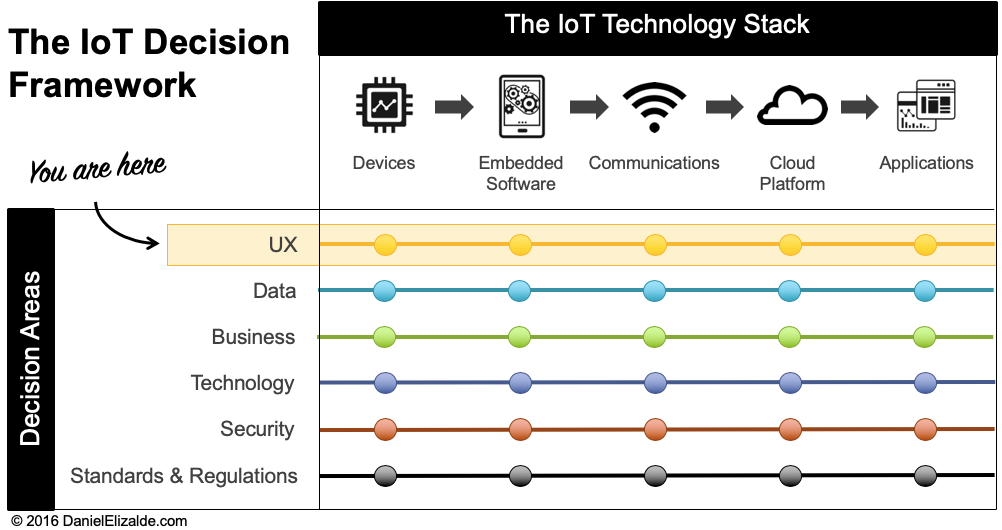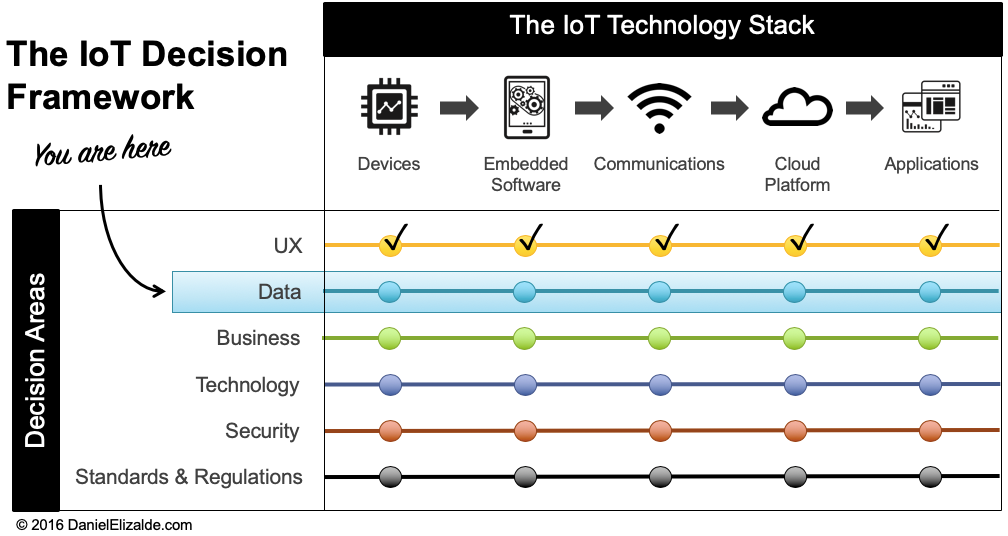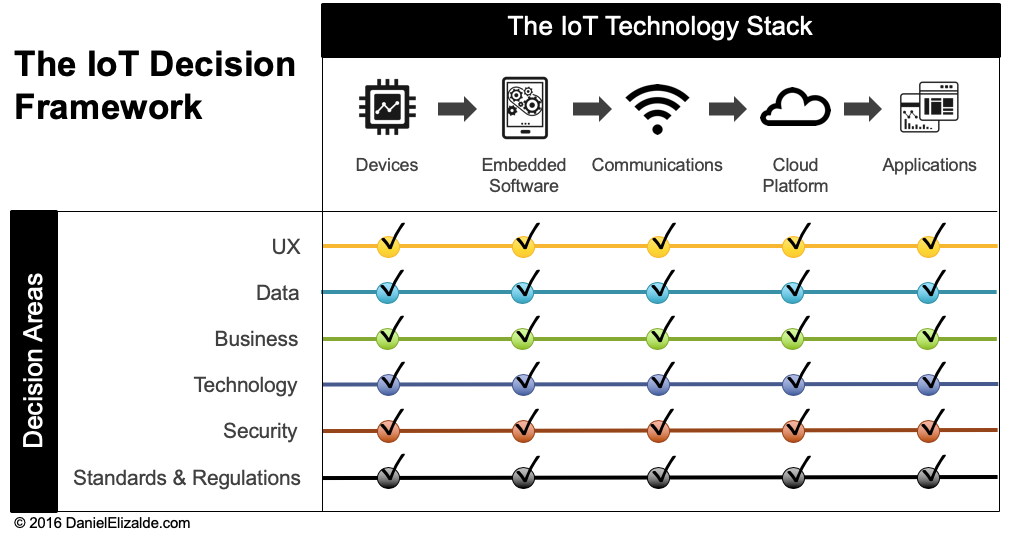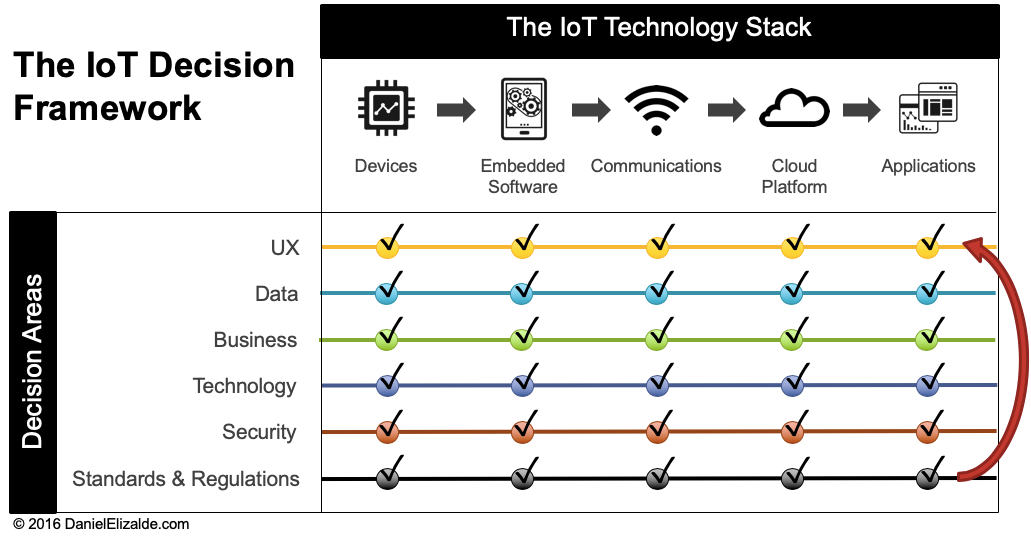
Product Management for an Internet of Things product can be very daunting and confusing, even for the most seasoned Product Managers. That’s because IoT products are more complex than your average product since you need to consider the complexity of five layers of technology: device hardware, device software, communications, cloud platform, and cloud applications.
You need to make critical business and technical decisions at each of these five layers and ensure this myriad of decisions is consistent with your overall strategy across the five layers. This exponentially increases the difficulty of managing an IoT product.
To help Product Managers tackle this complexity, I developed a framework I call the IoT Decision Framework.
This IoT framework provides a structured approach to creating a robust IoT product strategy. What I mean by that is this strategy is all about making decisions. The IoT Decision Framework helps you understand the areas where you need to make decisions and ensures consistency across all your strategic decisions.
My IoT framework will help you uncover pitfalls before you have invested time and money in the wrong direction with your product.
I’ve seen it firsthand when seasoned Product Managers from top Silicon Valley companies attend my IoT Product Management courses online at Stanford University or with my consulting clients.
Throughout my courses, participants drastically alter their product strategies as they work through the IoT Decision Framework. It helps them uncover questions they otherwise would not have considered that could make or break their products.
To start with the IoT Decision Framework, let’s look at the five layers of the IoT Technology Stack.
The 5 Layers of the IoT Technology Stack
The greatest challenge of managing an IoT solution is that there are five layers in the IoT technology stack, and decisions must be made at each layer.
In my previous post, Internet of Things: A Primer for Product Managers, I describe these five layers in detail. For reference, the five layers are:

To put things in perspective, a SaaS application only includes the two layers on the right side: Cloud Platform and Cloud Applications.
Those two layers alone are usually enough to keep any Product Manager on their toes. So, you can imagine how adding three extra layers becomes exponentially more complex because you must make decisions at each layer and ensure your decisions are consistent across all five layers.
As an IoT Product Manager, knowing where to start or how to organize your thoughts can be daunting. One of the most complex parts is knowing which questions you should be asking.
The Solution: An IoT Framework for Product Managers
The IoT Decision Framework provides a structured approach to uncover the questions you need to ask and navigate across the various departments to make the best decisions for your product.
Think of it as a map to help you discover all the necessary considerations as you build your IoT business plan, roadmap, backlog, etc.
The IoT Decision Framework focuses on six key Decision Areas you need to consider for any IoT product. These areas are:
- User Experience (UX)
- Data
- Business
- Technology
- Security
- Standards & Regulations

Each Decision area must be evaluated at each layer of the IoT Technology Stack. You’ll start with UX and work with your teams to discover what makes for a great user experience at the Device Hardware layer, then at the Device Software layer, and so on.

Then, you can move to the Data Decision Area and explore Data considerations for your Device Hardware, Data considerations for your Device Software, and so on.

Once you are done with the Data Decision Area of the IoT framework, you can move to the Business Decision Area. You get the idea. Continue through the framework left-to-right and top-to-bottom until you cover all areas.

I know this sounds like a lot of work, and it is. But believe me, you’ll be glad you spent the time thinking about the implications of all Decision Areas throughout the IoT stack before you start building anything.
That’s how you’ll create a consistent product strategy and learn about all the gaps that need further refining.
Each bubble in the IoT Decision Framework is an opportunity to use Product Management tools to make decisions and discover gaps—tools like market research, design research, customer development, prioritization, Lean, NPI, etc. This framework is not a replacement for any of those. On the contrary, it provides you with a map and a structure for your discovery process.
The Decision Areas of the IoT Decision Framework
It is very important to go through the IoT framework in order. Each Decision area is organized so that the information you collect in one area informs the subsequent area. I recommend you start with the UX Decision Area because you aim to understand your users’ needs first and then move to the other Decision Areas.
Let’s take a closer look at each Decision Area of the IoT framework.
1. User Experience (UX) Decision Area
In this area, you need to understand who your user is, their needs, and what would make for a great experience at each stack layer. Don’t worry about the technical details at this point. Just think about what this person wants, not how you will deliver it.
Plus, you’ll want to consider the needs of secondary users, like your internal Fleet Operations team, developer partners, sales team, installers, and more.
Related post: Why It’s So Hard to Create a Good User Experience in IoT
2. Data Decision Area
The goal of the Data Decision Area is to help you define your overall Data Strategy. In a nutshell, you need to decide how data should flow through the stack to fulfill the user’s needs.
For example, what type of data does your device need to produce? How much data should be transmitted to the cloud, and how often? Do you need to perform analytics at the edge, in the cloud, or both?
Related post: How to Differentiate Your IoT Product: Provide Insights Not Data
3. Business Decision Area
The goal of the Business Decision Area is to help you determine whether your product idea has financial potential. In other words, will you be able to make money?
Based on the user and data decisions you made in the previous decision areas, you can now begin to make business decisions that will feed into your business plan and financial projections.
For example, you’ll need to decide your overall business model and which layers of the IoT Technology Stack you will monetize and understand the costs of providing your service at each layer of the stack. You’ll also make critical business decisions, such as whether to build or buy each layer of the stack and whether to open APIs.
Related post: How to Monetize Your IoT Product
4. Technology Decision Area
Based on your decisions in all previous areas, it is time to work with your Technology teams to decide what technology is needed at each layer to deliver the final solution. The key here is not to choose the technology yourself but to provide your Engineering team with the information and requirements they need to choose the best technical solutions.
Together with Engineering, you’ll identify which sensors, device hardware, and device software are needed. You’ll design a communications topology and decide on communications protocols.
You’ll work with your team to choose a cloud platform based on data needs and performance requirements. You’ll also decide on the form factors of your cloud applications that best fit your users’ needs.
Related posts:
- How to Make Sense of IoT Hardware
- Behind the Scenes of the Microsoft Azure IoT Cloud Platform
- What is an IoT Platform?
5. Security Decision Area
Once you’ve worked with your teams to select the implementation technology, it is time to decide how to secure each stack layer.
The goal of the Security Decision Area is to help you think about how each layer could be compromised and how to respond when your devices are hacked. You’ll also need to decide whether you’ll implement security testing in-house or with a vendor and how to protect your product from being hacked from inside your own company (by employees or unwanted guests).
Related posts:
- How to Protect Your IoT Product from Hackers
- The Role of Product Managers in Securing the Internet of Things
6. Standards & Regulations Decision Area
During the last stage of my IoT framework, you’ll identify the standards and regulations that will affect your product at each layer of the stack based on your product type, customer, and industry.
For example, does your industry have a standard data format or communications protocol enabling your product to talk to other devices? Do your customers require you to meet certain device safety or cloud security requirements? What laws must your product comply with at each layer?
Iterate, Iterate, Iterate
There are a lot of decisions that you will need to make during the life of your product. You can’t expect to get them all right in the first pass. Therefore, it’s important for you to iterate several times throughout the IoT Decision Framework to make sure you find a balance across all the areas.
Your choices in each Decision Area and IoT Technology Stack layer will impact all of the other Decision Areas and stack layers. You’ll need to iterate several times across the framework before you reach a solution that is consistent with all the areas and has considered all the gaps.

For example, let’s say that in the Data Decision Area, you decide that, ideally, your product would provide real-time data to your user. In the Business area, you outline the costs of providing device hardware, device software, and a cloud platform that can handle real-time data. And that’s when you realize providing this service will cost more than what your customer is willing to pay.
So, you go back and decide that receiving data once per minute will be sufficient to meet your user’s needs. Then, you work through the UX, Business, and Technology Decision Areas once again to make all your decisions consistent with the new once-per-minute approach.
An IoT product is more of a system than a stand-alone product. Everything is interconnected. By using this framework, you can make sure your decisions across all layers are consistent.
What Questions Should I Be Asking at Each Decision Area?
You may have noticed that in this post, I’m only including the IoT framework, and I do not include a list of questions you should answer in each Decision Area. That’s because the exact questions will depend entirely on your industry, application, and goals for the particular release you are working on.
For example, the questions you’ll need to answer for a brand-new product or MVP will differ greatly from those you’ll need to answer for a mature product or even for a “version 2” product.
I designed the IoT framework as a tool to help you organize your thoughts and come up with the questions you need to answer as you develop your product strategy.
By the way, if you need more help figuring out the questions to ask or would like to go deeper, I recommend you check out my IoT courses for Product Managers. All of my IoT courses (either online or in-person) are built around the IoT Decision Framework as a way to help you and your team get a grip on your IoT product strategy quickly.
How to Get the Most Out of the IoT Decision Framework
When to Use this IoT Framework
You should use this IoT framework after you have done the preliminary product work, including defining your target audience, detailing your value proposition, analyzing competitors, and estimating the revenue opportunity.
Once you have a solid idea of how an IoT product can add value to your company and your customers, you can use this IoT framework to guide you through the decisions you must make at each layer of the IoT Technology Stack to support your overall goals.
Related article: People Don’t Buy IoT, They Buy a Solution to a Problem
You can also use the IoT Decision Framework when you are:
- Creating your business plan
- Defining your MVP
- Building and managing your roadmap
- Defining new features
- Considering a product line extension
- Evaluating potential partnerships
- Analyzing the risks of changing any area of the technology stack
Related article: How to Build an IoT Product Roadmap
Work as a Team
Product Managers are accountable for having a strong and consistent product strategy. But that doesn’t mean you should make your decisions in isolation. This IoT framework gives you an opportunity to collaborate with various departments to develop a common understanding of what the product will be.
Start by identifying who needs to be involved in creating your product strategy. Lead strategy workshops to make sure everyone is aligned; host working sessions with various departments (UX, Engineering, Finance, etc.) to gather information, generate questions for the framework, discuss options, and get feedback from stakeholders and executives.
The result will be a stronger, more consistent strategy and a deeper level of support from your peers and executives.
Frequently Asked Questions
Is this IoT framework designed for consumer IoT or industrial IoT products?
This framework can be used both with consumer and industrial IoT products. Consumer and industrial products have different outcomes, processes, and ecosystems. Although the process of creating those products is different, the process of creating the IoT product strategy is the same.
I know this because over 1,500 professionals have completed my IoT Product Management courses and have taken this knowledge back to their companies in all industries, verticals, and types of products.
Can I use the IoT Decision Framework for IoT product development?
The IoT decision framework is designed to help you with product strategy, not with product development.
However, the strategy informs your development process, so you need to understand the information the framework provides you before you jump into any development.
If you complete each component of the IoT Decision Framework, your team will have a much better sense of direction for your product; your product development process will be much more efficient, and you will deliver products to market faster and with less wasted development effort.
How long does it take to complete all areas of the IoT Decision Framework?
If you already have all the information, it can take as little as an hour to go over the framework. For example, if you know your target audience, have identified all of your users, and created all their personas, then going through the UX Decision Area will be a breeze.
The same is true for all the other Decision Areas. If you don’t have the information, it will take you longer to complete the framework because you must complete some research. That is one of the biggest benefits of using this framework: the IoT Decision Framework can help you understand where you need to conduct research.
In a way, it will provide you with a roadmap for your product team on what research activities you need to define, where you need buy-in from internal stakeholders, the areas you need to discuss with engineering, how to approach security, and how to engage your policy team.
It’s not about how long it takes you to go through the framework itself. It’s about understanding all of the questions you need to ask and how to create a product strategy that can lead to a successful market fit.
Why does the framework start with UX? Shouldn’t we start with IoT technology instead?
No. The IoT Decision Framework intentionally starts with the UX Decision Area because, from a Product Management perspective, understanding your users is the most important activity you can do. If you don’t understand your users and can’t articulate their pain points, it will be very hard to create a data strategy, business model, or technology strategy.
Many companies start with a technology-first approach, meaning they develop some piece of technology and then attempt to find a problem their product solves. But that approach is backward.
We need to start with understanding our users, and from there, we can figure out how the user’s needs flow throughout the rest of the framework, including data strategy, business models, and build vs. buy strategy. Only then can we start working on a technical solution. Remember, Product Management is about being customer-focused, not technology-focused.
Are there any templates I can use to go through the framework?
Yes. I’ve included several templates you can use with your team in my IoT Product Manager Certificate Program. The program includes my IoT Decision Workbook, a companion to the IoT Decision Framework.
Another great tool is my IoT strategy template, which you can download for free.
The IoT strategy template is a PowerPoint template you can use to summarize the findings in the IoT Decision Workbook so you can communicate with other stakeholders in your company and articulate the product strategy.
These are the same templates I use with my consulting clients and in my IoT PM classes at Stanford University.
How can I use the IoT Decision Framework to create my IoT roadmap?
Once you go through the framework, you will have all the necessary information to create a product roadmap.
I recommend reading my article on how to create an IoT product roadmap. That article is based on the IoT Decision Framework and will give you the steps necessary to go from strategy to an actual roadmap.
The Bottom Line
IoT products are more complex than most other technology products. The IoT Decision Framework can help you organize your thoughts, identify opportunities and pitfalls, achieve consensus, and release the right solution faster.
IoT Decision Framework, Copyright © 2016, Daniel Elizalde LLC – All Rights Reserved.
19 Comments
-
IoT products are more complex than most other technology products. Using the IoT Decision Framework can help you organize your thoughts, identify opportunities and pitfalls, achieve consensus, and release the right solution faster.
-
Amazing Article.. thank you for sharing
-
Amazing explanation for IoT framework. It will help really help product managers to understand the actual product requirement and the structure. Thanks!
-
Very very helpful article..!! Thank you Daniel
-
I really wanted to keep on reading! I am going to certainly pply some of the ideas myself, you are
brilliant. Do you do consultancy? -
Hi Daniel,
I’m IoT product manager and business developer in Toulouse (France).
You analysis of the IoT market is so true (This article and also”People Don’t Buy IoT, They Buy a Solution to a Problem”).
You exactly demonstrate what I think since two years. But today I think IoT major company destroyed what could be IoT by adding stupid smart think to product that don’t need it. Everybody install IoT solution but they don’t understand what to expect exception to the fashion around this technology.
So there are a lot of IoT proof of concept but at least nearly nothing is deployed at a large scale.You should send this framwork to all innovation manager in large company and incubator . They need to think deeply and think again about problem and then IoT solution not only IoT technology.
Thank you
-
great article. i feel while some use cases will be useful in an on prem scenario. use of machine learning and ai will require cloud.
-
Good points Satish. Thank you for your comment.
-
-
Thanks for sharing… Very much useful.
-
Great work, thank you for sharing
-
Thank you Cameron.
-
-
Very helpful framework Daniel, just listened to your interview on the IoT Podcast. I’ll share this with the IoT Auckland Meetup group and I’m sure it will help educate on the process for managing an IoT project.
-
Thank you John. I’m glad you found it useful.
Best,
Daniel
-
-
Thanks for sharing, very insightful indeed.
-
Thank you Nasir.
-
-
Great stuff Daniel !! Looking forward to hear from you in more details in the Stanford class tonight..
-
Good stuff. I like the framework and the 5 levels.
Although I think the Cloud is the right way to categorize that level, in fact, some companies will still have on-prem for some applications so either Cloud or On-prem at that level.
Very thorough. Look forward to following up with you.
Chris
-
Thank you for your comment Chris. I agree. The Cloud will be future state, but we will see many implementations along the way as companies adapt their existing technologies and infrastructure to the concept of IoT.
I look forward to following up with you as well.
-Daniel
-
Pingbacks
-
[…] Ask all the right questions? Ask those questions in the right order? That’s where the IoT Decision Framework by Daniel Elizalde comes in and does a great […]
[…] Ask all the right questions? Ask those questions in the right order? That’s where the IoT Decision Framework by Daniel Elizalde comes in and does a great […]